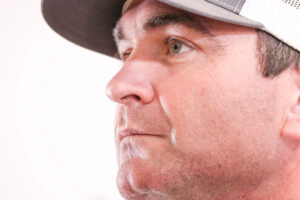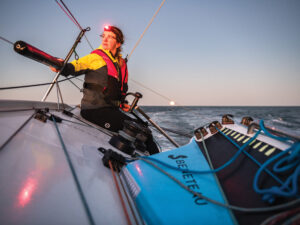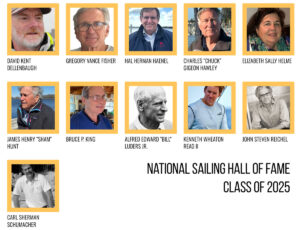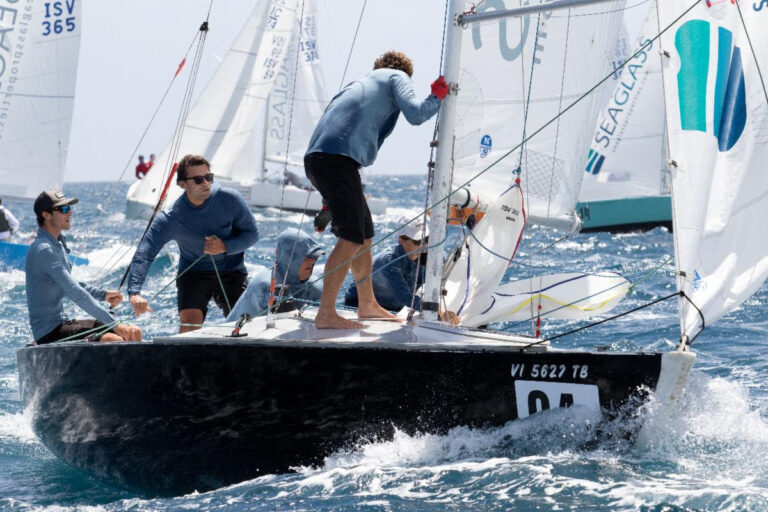Earlier today, John Kosteckis illbruck Challenge was first around Isla Trinidade, the second waypoint of the Volvo Ocean Races first leg. Consequently, they were the first to turn the corner and start what will likely be a long, upwind slog to Cape Town some 2,500 miles away.
“Today marked a big change in the race as for the first time we headed east and in the general direction of Cape Town,” wrote illbruck watch leader Mark Christensen. “We knew the fleet would compress behind us as we would be going on the wind and not laying Cape Town while the others reached in behind. What we werent prepared for was the big cloud that parked us for two hours. Now we are upwind, the course is 143 degrees and the wind is shifting from 100 to 160. Anything left of 143 we are on port and right of 143, starboard.”
Hot on their transom was Roy Heiner and Mark Rudigers Assa Abloy, which rounded Trinidade at 1140 GMT today. Only 26 miles currently separate the two, and as Rudiger hinted to in e-mail today, the battle for the lead is far from over. “Its Cape Town or bust,” he said. “It will be very interesting to see how everyone deals with the open space now and the numerous options.”
Rudiger also expressed concern that he would be unable to download weather data over the next few days, reporting that the boat’s Satcom B had been down for days. “The boats that can keep all this working will really have edge given the tricky calls coming up,” he said. “As always, we’ll do the best that we can with what we have and be thankful.”
There is a complex mix of weather in the South Atlantic, and some unusual scenarios. The rule of thumb for this portion of the leg is to dive south and connect with one of the many low-pressure systems that slide west to east, thereby avoiding the South Atlantic High. But the High isn’t living up to its reputation and it’s stretched across the rhumb line with no easy way around it.
“The only way around is to sail east and then south,” said Christensen. “All the weather routing programs agree but history strongly disagrees. It seems that all teams believe their routing programs. The next few days should initially compress the fleet some more before a new easterly and then northerly wind fills in. The leading boats will initially stretch out again, but after that the routing programs run out of information. Still a long way to go.”
At the 1600 position report, Kevin Shoebridges Team Tyco, Jez Fanstone and Ross Fields Team News Corp, and Amer Sports One, respectively, were all within 40 miles of illbruck and more than 400 miles ahead of the three backmarkers-Gurra Krantzs Team SEB, Lisa Charles Amer Sports Too, and Knut Frostads Djuice Dragons. Amer had passed the Dragons over the weekend as they briefly stopped for spares in Fernando de Noronha. “The joy and pleasure of getting new spare parts and extra food has not lasted long,” wrote Frostad this morning. “Apart from now being able to make fresh water the proper way, we have been struggling the last 24 hours. We have been chased by girls day and night. After we had them clear behind us before the island, having gained more than 100 miles on them the last couple of days, they were obviously out for some revenge. We had them only one mile away after losing 5 miles during our pit stop, and since then they have been clever making our lives miserable.”
Yesterday, a mild state of misery descended upon SEB as well, when, for the second time, their headboard car failed. This time, the spare theyd picked up in the Canary Islands, failed in the same way as the first. “The replacement part was of the same design as the original,” said Krantz. “Looking at the bit that broke off it seems like it is designed for something other than a round the world race. Should we have known this? Possibly, but we have never had a problem before and surely one would expect the lessons learned from last years Sydney to Hobart race to have been implemented.
“We are all a bit gutted to loose miles again. Position report after position report, we have been able to stretch on the boats behind us. Hard and intensive sailing has been rewarded with a few miles every report. Some of it is now, again, taken away from us. Fantastic recovery to be back in action in two hours, but the result is that we have lost distance and height, plus now we have a mainsail that is complicated to reef. We now have to see at the next report exactly how much this has cost us.”









